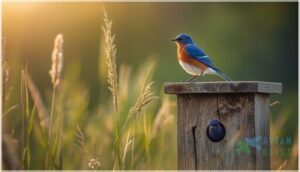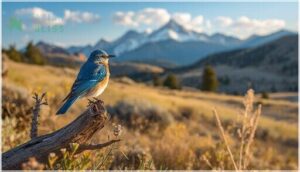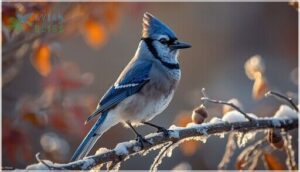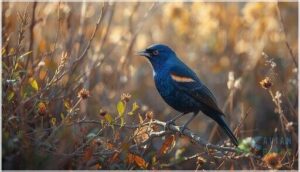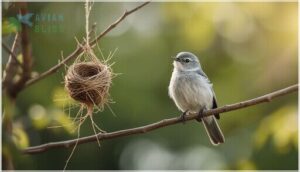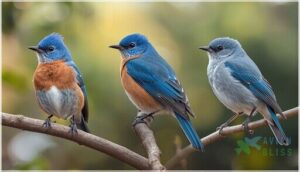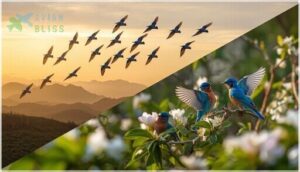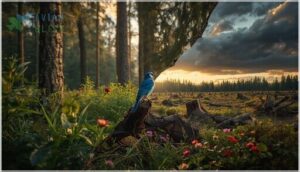This site is supported by our readers. We may earn a commission, at no cost to you, if you purchase through links.
The first flash of blue through your binoculars transforms an ordinary backyard into something remarkable. You’ve just spotted one of North America’s most enchanting avian residents—but which species? Seven distinct types of blue birds inhabit different regions across the continent, each with unique field marks that separate the sky-blue Mountain Bluebird from the cobalt-crested Blue Jay.
Misidentification happens often because blue plumage varies dramatically depending on light conditions and viewing angles. Understanding the structural differences in size, habitat preferences, and vocal patterns helps you move beyond guessing.
Whether you’re identifying a rusty-chested Eastern Bluebird at your feeder or tracking the electric indigo flash of a breeding bunting, recognizing these species opens up a richer connection to the ecosystems around you.
Table Of Contents
- Key Takeaways
- Common Types of Blue Birds
- Blue Bird Identification Tips
- Habitats of Blue Birds
- Migration and Behavior Patterns
- Conservation Status and Threats
- Frequently Asked Questions (FAQs)
- What bird is blue but not a bluebird?
- Are there different varieties of bluebirds?
- What does it mean when you see a lot of bluebirds in your yard?
- What are some blue bird names?
- What are the three types of bluebirds?
- What kind of bird is Royal blue?
- What is a small solid blue bird?
- Are blue birds naturally aggressive toward other birds?
- How long do blue birds typically live?
- Can blue birds be kept as pets legally?
- Conclusion
Key Takeaways
- Seven distinct blue bird species inhabit North America with identifying features including size differences (Blue-gray Gnatcatcher at 4.7–5.5 inches versus Blue Jay at 9–12 inches), plumage patterns (rusty chest on Eastern Bluebird, uniform sky-blue on Mountain Bluebird), and structural coloration that scatters light rather than using blue pigment.
- Habitat preferences separate species effectively: Eastern Bluebirds thrive in open woodlands with cavity-nesting sites, Mountain Bluebirds occupy high-elevation sagebrush between 5,000–11,000 feet, Cerulean Warblers require mature deciduous forest canopies, and Blue Jays adapt readily to suburban yards.
- Migration patterns vary dramatically—Indigo Buntings and Cerulean Warblers undertake long-distance flights to Central America while Blue Jays and Eastern Bluebirds remain year-round residents in many regions, with some populations shifting only during harsh winters.
- Conservation threats center on habitat loss and fragmentation that reduce breeding success through smaller clutch sizes, increased nest predation, and diminished insect prey, making backyard habitat restoration with native plants and proper nest boxes critical for supporting vulnerable populations like the declining Cerulean Warbler.
Common Types of Blue Birds
North America hosts a striking variety of blue-feathered birds, each with distinctive markings and behaviors that make identification both challenging and rewarding. From the vivid azure of bluebirds to the deep navy of jays, these species occupy diverse habitats across the continent.
Among these, the Blue Jay stands out as one of the most intelligent species, particularly common in regions like Delaware’s backyard habitats.
Here are eight common blue birds you’re likely to encounter in forests, meadows, and even your own backyard.
If you’re hoping to see bluebirds up close, check out these proven tips for attracting bluebirds to your yard based on their regional habits.
Eastern Bluebird
The Eastern Bluebird (Sialia sialis) stands out with males displaying vivid blue upperparts and rusty chest plumage, while females show subtler tones. You’ll find these bird species weighing 26–32 grams across eastern North America.
Their distinctive coloring makes them easy to spot among other blue birds in Georgia, especially during spring migration when males are in full breeding plumage.
Their nesting habits include cavity use and nest boxes, with breeding seasons producing 3–5 eggs.
If you’re exploring Florida’s diverse avian life, check out this guide to black birds in Florida to see which cavity-nesting species share similar breeding patterns.
Migration patterns take them southward in winter, though conservation status remains stable through habitat restoration efforts.
Western Bluebird
Moving west, you’ll spot the Western Bluebird (Sialia mexicana) in open woodlands and grasslands from Washington to Mexico, generally between 1,000 and 7,000 feet elevation. Males show vivid blue upperparts with rusty chest patches.
Their nesting habits mirror their eastern cousins, using cavities in deciduous trees near meadows. Migration patterns shift birds to higher elevations during breeding seasons, where food sources like ground insects sustain them.
Mountain Bluebird
At higher elevations—often 5,000 to 11,000 feet—you’ll encounter the Mountain Bluebird (Sialia currucoides) across western North America’s sagebrush and alpine meadows. Males display stunning sky-blue plumage without any rusty tones, making bird species identification straightforward.
Their breeding habits and migration patterns reflect elevation shifts rather than long-distance travel:
- Nesting behavior includes cavity use in open ponderosa pine and juniper woodlands
- Feather structure creates their pale blue coloration through light scattering
- Habitat and distribution span Rocky Mountain region foothills to plateau areas
- Habitat conservation efforts focus on protecting high-desert breeding grounds
Blue Jay
You won’t mistake the Blue Jay (Cyanocitta cristata)—this bold, crested species brings vibrant cobalt blues and raucous calls to deciduous forests and suburban yards across eastern North America. Intelligence studies reveal their exceptional problem-solving abilities and complex social behavior within family groups.
Their bird behavior and migration patterns show minimal movement, though northern populations shift southward during harsh winters. Wildlife conservation efforts benefit from their adaptability, making bird species identification straightforward for backyard observers.
| Feature | Description | Field Notes |
|---|---|---|
| Blue Jay Diet | Omnivorous—acorns, insects, seeds | Caches food for winter |
| Feather Structure | Structural coloration creates blue | No blue pigment present |
| Nesting Habits | Stick nests 10-25 feet high | Monogamous pairs cooperate |
| Habitat and Distribution | Eastern woodlands to backyards | Year-round resident species |
Indigo Bunting
A flash of electric indigo signals a male Indigo Bunting (Passerina cyanea) in breeding plumage—one of blue birds’ most striking migratory species. Their feather structure creates vivid blue through light scattering, not pigment.
These buntings thrive in open woodlands and brushy edges where native habitat characteristics support their insect-rich diet during breeding season.
These seed-eating songbirds navigate via celestial navigation during nocturnal migration between brushy breeding habitats and tropical wintering grounds.
Wildlife conservation efforts and habitat preservation support their breeding habits in shrubby forest edges. The Indigo Bunting’s population trends can be understood through breeding bird surveys.
Blue Grosbeak
Among types of blue birds, the Blue Grosbeak (Passerina caerulea) stands out with rich cobalt plumage and rusty wing bars. Males display deeper blue coloration than females’ brownish-gray tones—key for bird identification. Their feather structure creates blue through light scattering, similar to other blue bird species.
These medium-sized songbirds favor brushy habitat edges, delivering flute-like song patterns during breeding season before bird migration to Central America.
Cerulean Warbler
The Cerulean Warbler (Setophaga cerulea) represents one of the most declining blue birds in eastern North America. You’ll spot males by their sky-blue upperparts and white underparts during breeding season in mature deciduous forests.
- Migration routes extend from eastern forests to northern South America
- Breeding patterns include 3–5 egg clutches in elevated canopy nests
- Habitat restoration focuses on protecting continuous forest blocks
- Conservation efforts address population declines through monitoring programs
- Nesting behaviors occur in high canopy forks along riparian zones
Blue-gray Gnatcatcher
The Blue-gray Gnatcatcher (Polioptila caerulea) measures just 4.7–5.5 inches, making it one of North America’s smallest blue birds. You’ll recognize this bird species by its pale gray plumage and distinctive white eye ring.
Nesting habits include intricate constructions using spider webs and plant material.
Migration routes vary by population, with some groups moving between breeding seasons while others remain year-round residents across diverse habitats.
Blue Bird Identification Tips
Identifying blue birds in the field requires careful attention to several key features that distinguish one species from another. You’ll want to observe the bird’s physical characteristics, listen to its voice, and note any unique patterns or markings.
Here are the most reliable identification methods to help you confidently name the blue bird you’ve spotted.
Plumage Color and Patterns
When you’re identifying blue birds, understanding plumage color and patterns unlocks the mystery. Blue pigmentation arises from feather structure—microscopic patterns scatter light rather than traditional pigments. You’ll notice color variation across avian species: males display vibrant blues during breeding season, while females show subdued tones. Iridescence effects shift with viewing angle, especially in types of blue birds like buntings and bluebirds.
- Male plumage usually shows brighter, more saturated blues than females year-round
- Iridescent blues require specific light angles to reveal their full intensity
- Wing bars and tail markings in contrasting colors aid species identification
- Seasonal molts can temporarily reduce blue saturation in some species
- Underpart patterns (white, spotted, or buff) provide critical distinguishing features
Size and Shape Differences
You’ll find notable variation in body proportions and beak shapes across North American blue birds. Eastern Bluebirds measure 5.5 to 7 inches with compact builds, while Blue Jays reach 9 to 12 inches with sturdy frames.
Wing span and tail sizes differ substantially—Mountain Bluebirds show slender profiles, whereas Indigo Buntings present smaller, conical beaks. These structural differences make identifying bird species straightforward once you understand feather length patterns.
Distinctive Markings
You can rely on facial patterns and wing bars to separate species at a glance. Eastern Bluebird males show rust-orange throats, while Western Bluebirds display blue throat patches. Mountain Bluebirds lack the warm tones entirely.
Look for white wing bars on jays, eye rings on gnatcatchers, and scalloped feather colors that shift with breeding seasons—these plumage and coloration details make identification reliable.
Song and Vocalizations
Once you’ve noted the distinctive markings, listen for vocalizations that confirm your identification. Eastern Bluebirds deliver soft, warbling melodies with 5–20 distinct phrases, while Western Bluebirds produce shorter, choppier calls. Mountain Bluebirds sing rapid trills during breeding season.
These song patterns and trill variations reflect bird behavior tied to territorial defense. Vocal learning shapes each species’ melodic structure, making bird calls reliable identification tools for blue bird conservation efforts.
Habitats of Blue Birds
You’ll find blue birds thriving in surprisingly diverse environments across North America, from dense forest canopies to your own backyard feeders.
Each species has adapted to specific habitat types that provide the food, shelter, and nesting sites they need to survive.
Understanding where these birds live can help you spot them in the wild and create welcoming spaces in your own landscape.
Forest and Woodland Areas
Dense canopies and understory layers make forest ecology essential for blue birds like the Indigo Bunting and Cerulean Warbler. You’ll discover these avian ecology gems in habitats offering:
- Tree cavities in mature forests where Eastern Bluebird, Western Bluebird, and Mountain Bluebird nest
- Riparian zones along streams with higher insect diversity
- Mixed deciduous-coniferous woodland habitat providing seasonal berries
- Standing deadwood management creating foraging perches
- Forest edges balancing visibility with predator detection for various bird species
Grasslands and Meadows
Open meadows and prairies reveal a different blue bird story. You’ll spot Eastern Bluebirds and Mountain Bluebirds hunting beetles and grasshoppers in tallgrass stands where insect prey peaks mid-summer. Grassland ecology drives everything—controlled burns and meadow management boost forage availability and nesting habitats. When drought strikes, insect biomass drops, lowering fledging success rates you can track during bird-watching seasons.
| Habitat Feature | Blue Bird Benefit |
|---|---|
| Flowering forbs | Peak insect prey for nestlings |
| Tall native grasses | Nest concealment from aerial predators |
| Meadow edges | Perch sites near foraging zones |
| Heterogeneous structure | Higher arthropod diversity year-round |
Wetlands and Riparian Zones
Along streams and marshes, you’ll discover blue birds like Eastern Bluebirds and Belted Kingfishers thriving where wetland ecology meets riparian conservation. Water quality influences insect abundance—their primary prey—while dense vegetation offers nest sites and predator protection.
Habitat restoration projects boost ecosystem services that support bird watching hotspots.
When water levels shift, you’ll notice changes in foraging success and breeding patterns worth tracking.
Urban and Backyard Environments
Your backyard can become a blue bird sanctuary with thoughtful yard management and garden design. Eastern and Western Bluebirds adapt well to urban wildlife corridors when you provide proper nest boxes 5–6 feet high facing open space.
- Install bluebird-specific boxes in quiet, vegetated areas to minimize light and noise pollution
- Plant native fruiting shrubs and deciduous trees that support insect diversity for bird friendly feeding habits and diet
- Maintain open lawn patches adjacent to perching sites for effective foraging
- Limit supplemental feeding to approved foods that support backyard birding without creating dependency
- Create dark-sky-friendly spaces with reduced artificial lighting to improve breeding success for bird species you’re watching
Strategic urban bird watching tips increase blue birds’ nesting opportunities in city-adjacent neighborhoods.
Migration and Behavior Patterns
Understanding how blue birds move and interact reveals patterns that shape their survival throughout the year. Some species follow ancient migratory routes, while others stay put, and their breeding behaviors show striking adaptations to local conditions.
Let’s explore the key movement patterns and social behaviors that define these birds’ lives.
Migratory Blue Bird Species
Several blue bird species begin extraordinary journeys each year, driven by seasonal adaptation to food and climate. The Indigo Bunting and Cerulean Warbler undertake long-distance flight to Central America, while the Mountain Bluebird demonstrates altitudinal movement within western ranges.
These migration patterns rely on critical stopover sites along major flyways, where you’ll find exhausted travelers refueling during spring and fall. Understanding these behaviors helps you time your observations perfectly.
Year-round Resident Species
While many blue birds chase warmer skies, you’ll find dedicated year-round residents holding stable territory through all seasons.
The Eastern Bluebird, Western Bluebird, and Blue Jay demonstrate exceptional year-round adaptations, maintaining localized populations where food and shelter persist.
Mountain Bluebird occupies higher elevations year-round, while the Blue-gray Gnatcatcher shows resident species traits in southern microclimates, exemplifying persistent resident bird behavior.
Breeding and Nesting Habits
You’ll notice blue birds display striking breeding and nesting precision across species diversity. Eastern Bluebirds usually produce 4 to 6 eggs per clutch with 13 to 14-day incubation periods, while Mountain Bluebirds raise 2 to 3 broods seasonally.
Nesting sites vary—cavity nesters like bluebirds versus cup-nest builders like Indigo Buntings, who select dense vegetation. Nesting materials include plant fibers, grasses, and spider webs, showcasing adaptive habitat utilization during breeding seasons.
Social Structure and Flocking
You’ll find that blue birds navigate their social worlds with as much strategy as they do the skies, forming flocks that shift with the seasons and survival needs. Blue jays exhibit complex behaviors related to their social structure dynamics.
Key social patterns you’ll observe include:
- Flock dynamics: Winter aggregations enable group foraging and predator vigilance across diverse bird species.
- Social hierarchy: Dominance structures emerge during feeding, shaping avian world interactions and bird communication patterns.
- Cooperative breeding: Some species share parental duties, strengthening survival rates.
Conservation Status and Threats
While many blue bird species thrive across North America, some face serious challenges that threaten their survival. Habitat destruction, climate shifts, and environmental pressures have pushed certain species onto vulnerable and endangered lists.
Understanding these threats—and the actions you can take to help—makes a real difference in protecting these extraordinary birds for future generations.
Endangered and Vulnerable Species
The delicate balance of blue bird populations teeters on a knife’s edge, with species like the Cerulean Warbler facing uncertain futures as their numbers steadily decline. The IUCN Red List classifies this warbler as Vulnerable—a status that demands immediate conservation efforts.
Some blue bird species, like the Vulnerable Cerulean Warbler, face declining populations that demand immediate conservation action
Species research and threat analysis reveal that recovery plans must prioritize biodiversity preservation through targeted wildlife conservation strategies and thorough ornithology studies.
Habitat Loss and Fragmentation
Understanding threats to blue birds starts with habitat destruction—the silent killer reshaping landscapes where these species evolved. When forests fall and grasslands fragment, you’re witnessing biodiversity loss that ripples through entire ecosystems.
Fragmentation effects create isolated patches where cavity-nesting bluebirds struggle with:
- Reduced breeding habitat and smaller clutch sizes
- Increased nest predation from edge-dwelling predators
- Diminished insect prey abundance affecting foraging success
- Greater energetic costs traveling between disconnected sites
- Declining genetic exchange raising inbreeding risks
Ecosystem disruption from urban expansion forces wildlife conservation to prioritize habitat connectivity—your environmental conservation efforts matter for biodiversity and species preservation.
How to Support Blue Bird Populations
Protecting blue birds means taking action in your own backyard. You can start with habitat restoration—planting native vegetation nourishes insects they depend on.
Proper nest box management provides essential breeding sites, while pesticide reduction protects their food chain. Water conservation maintains riparian zones they frequent.
Join citizen science projects tracking populations—your observations strengthen biodiversity and species preservation efforts. Environmental conservation starts locally.
Frequently Asked Questions (FAQs)
What bird is blue but not a bluebird?
Several striking birds wear blue without belonging to the bluebird family. Blue Jays flash bold azure wings, while Indigo Buntings and Blue Grosbeaks display deep sapphire plumage that rivals any true bluebird’s coloration.
Are there different varieties of bluebirds?
Yes, you’ll encounter three main bluebird species across North America: Eastern, Western, and Mountain bluebirds. Each inhabits distinct regions with unique feather colors and nesting habits, making conservation efforts vital for protecting these beloved blue birds.
What does it mean when you see a lot of bluebirds in your yard?
When bluebirds flock to your yard, it’s like striking gold—you’ve created prime habitat quality.
Your space offers nesting success through boxes, food availability via insects, and open perches that support healthy bluebird behavior and migration patterns.
What are some blue bird names?
You’ll encounter striking species like the Blue Jay, Indigo Bunting, Lazuli Bunting, and Blue Grosbeak across North America.
Regional birds include Eastern, Western, and Mountain Bluebirds, each showing distinct color variations.
What are the three types of bluebirds?
You’ll find three distinct bluebird species across North America: the Eastern Bluebird inhabits eastern regions, Western Bluebird ranges through western states, and Mountain Bluebird prefers higher elevations with unique pale-blue plumage.
What kind of bird is Royal blue?
Royal blue” isn’t a species—it describes vivid color variation in male Indigo Buntings and Blue Jays during breeding season.
Their royal plumage comes from feather structure scattering light, not pigment, creating those striking blue feathers.
What is a small solid blue bird?
You’re likely spotting an Indigo Bunting—a small species measuring 11–13 cm with uniform blue plumage across its body.
These compact birds showcase vivid feather structure that creates their striking blue appearance through light scattering.
Are blue birds naturally aggressive toward other birds?
Think of territorial behavior like invisible property lines—blue birds defend their spaces differently. Blue Jays and Steller’s Jays show heightened aggression during breeding season, while social hierarchy and behavioral traits determine most avian interactions and conflict resolution.
How long do blue birds typically live?
You’ll find most blue birds live surprisingly different lifespans—Eastern Bluebirds reach about 6 years, while Blue Jays can survive over a decade.
Survival rates depend heavily on habitat quality and predation pressure.
Can blue birds be kept as pets legally?
You can’t legally keep native blue birds as pets in the United States without wildlife permits. The Migratory Bird Treaty Act protects most species, making unauthorized possession subject to legal consequences and supporting broader conservation efforts.
Conclusion
Backyard birding becomes boundless when you can confidently distinguish these types of blue birds by their field marks, songs, and seasonal movements. Each species plays a key role in its ecosystem—from controlling insect populations to dispersing seeds across fragmented habitats.
Your observations contribute to citizen science efforts that track population trends and inform conservation strategies. Keep your binoculars ready, note unusual behaviors, and report your sightings. Every identification sharpens your skills and deepens your connection to the avian world around you.


